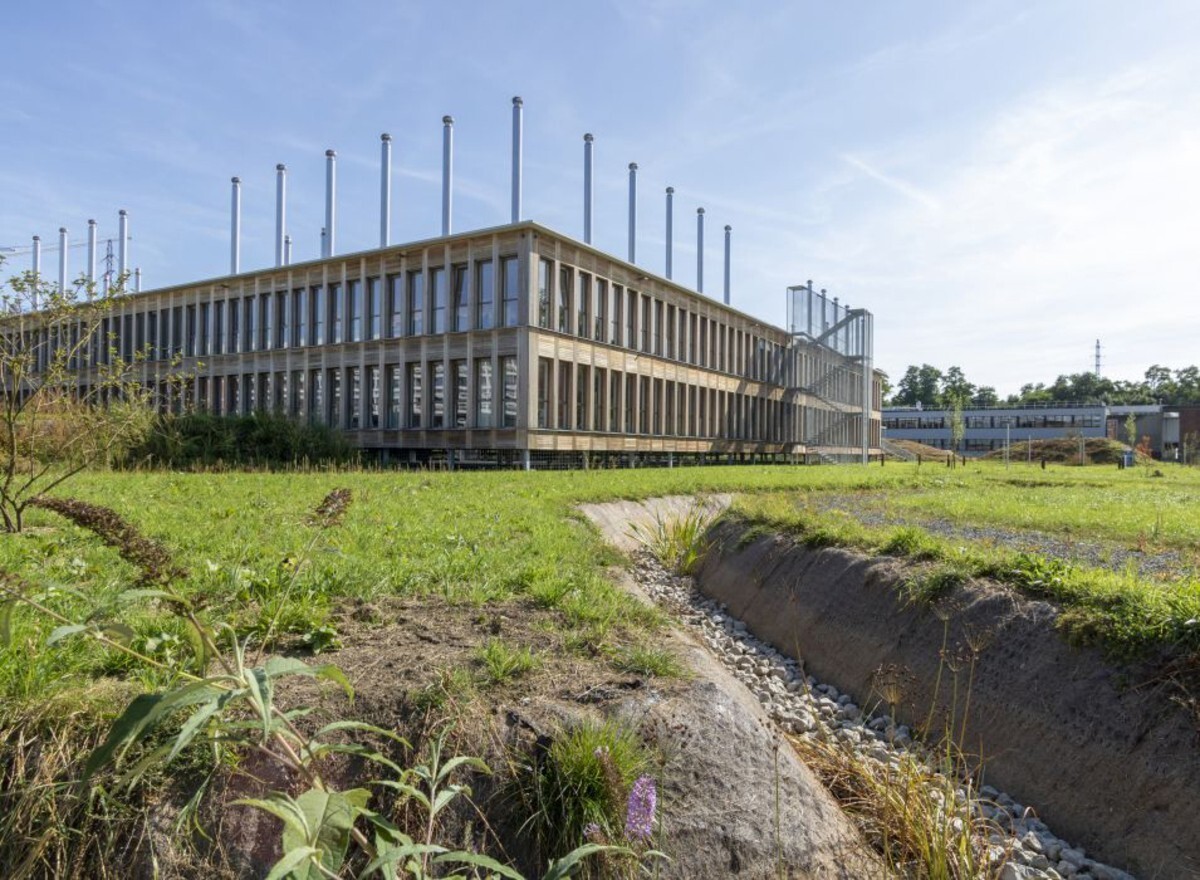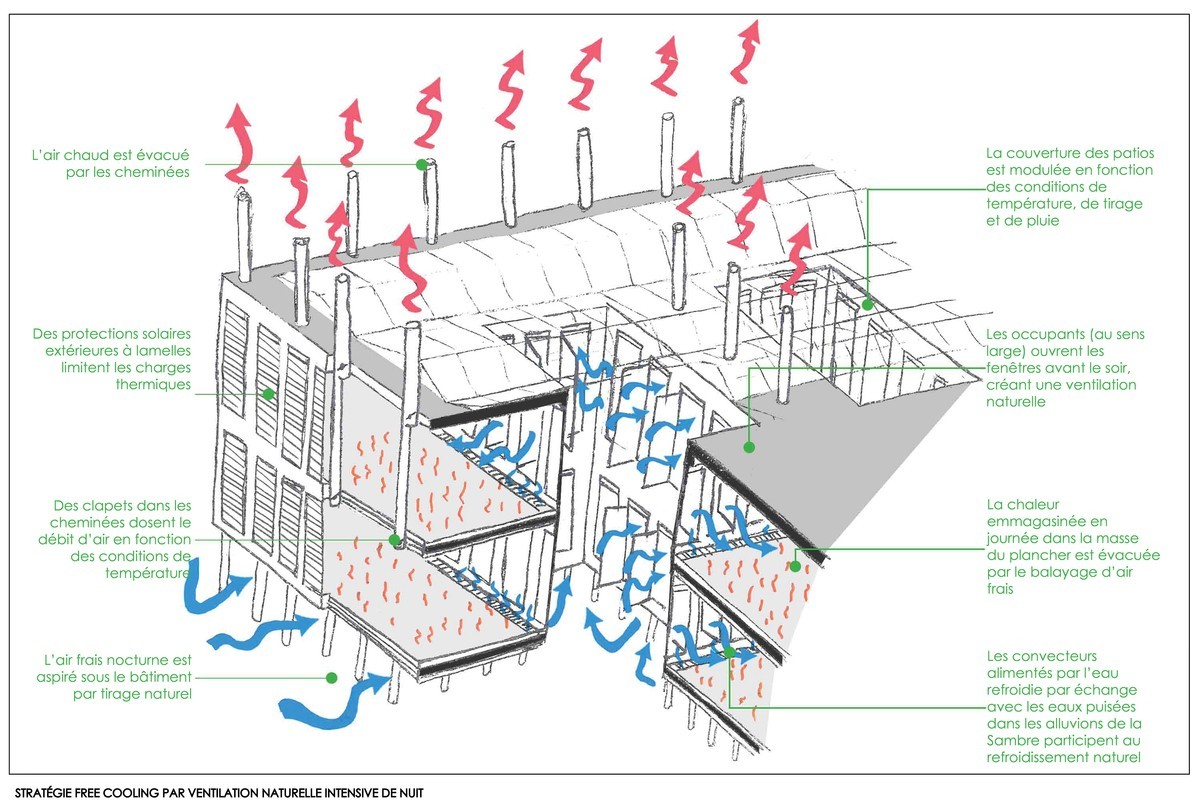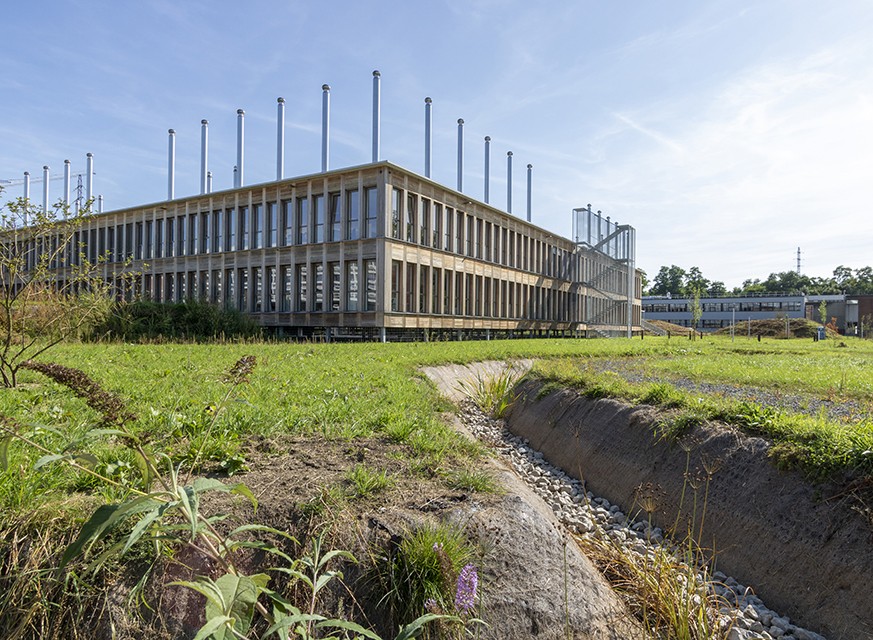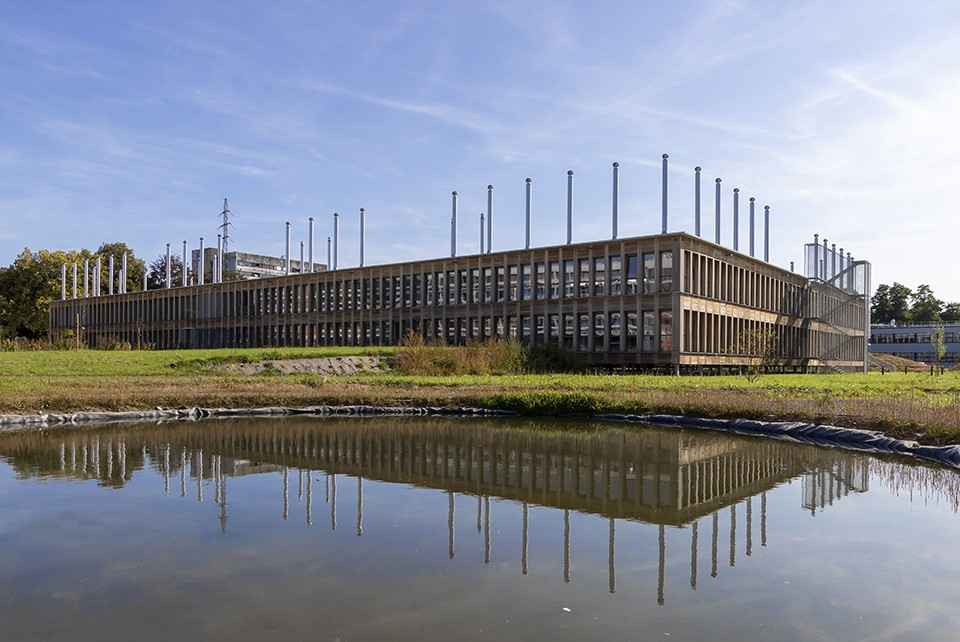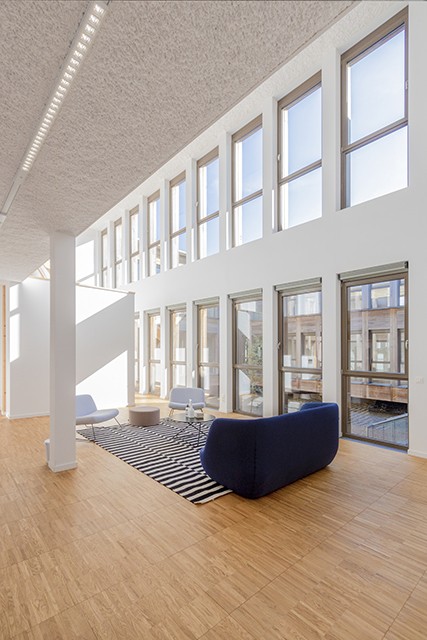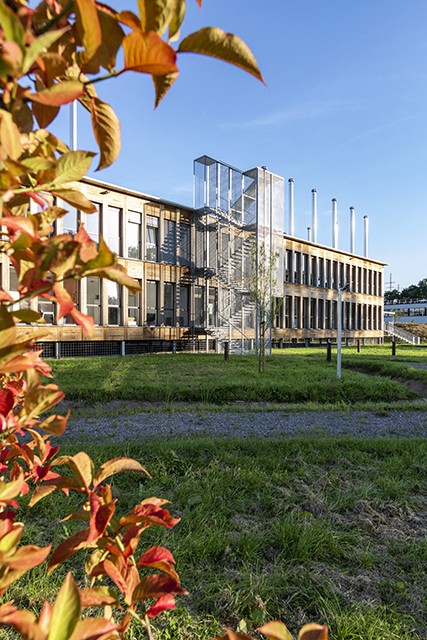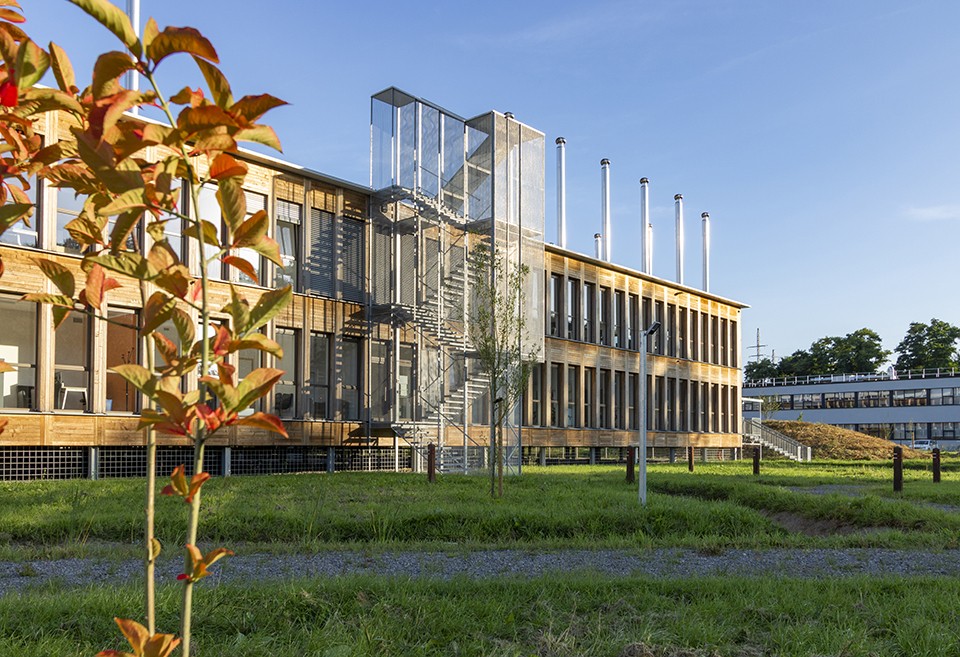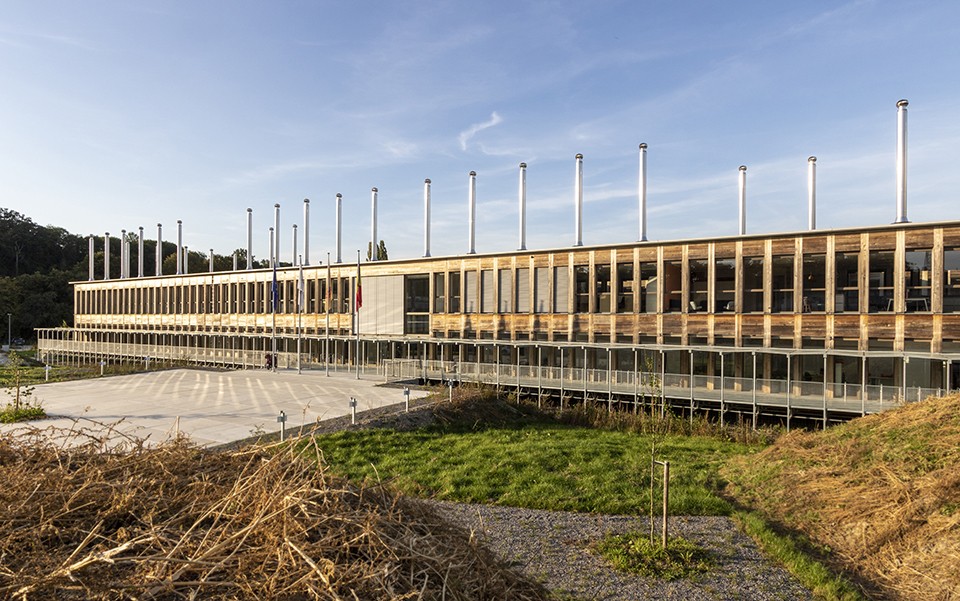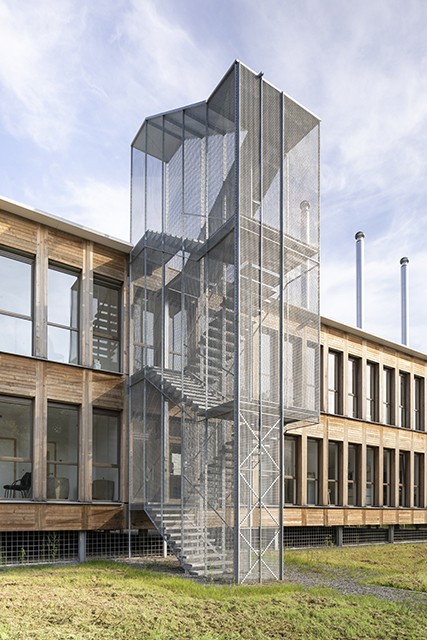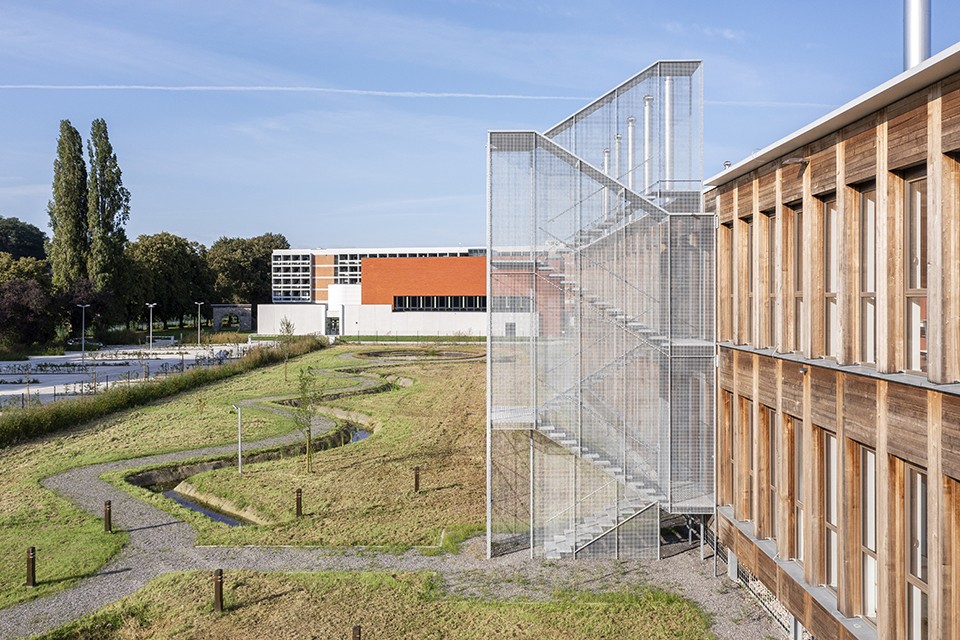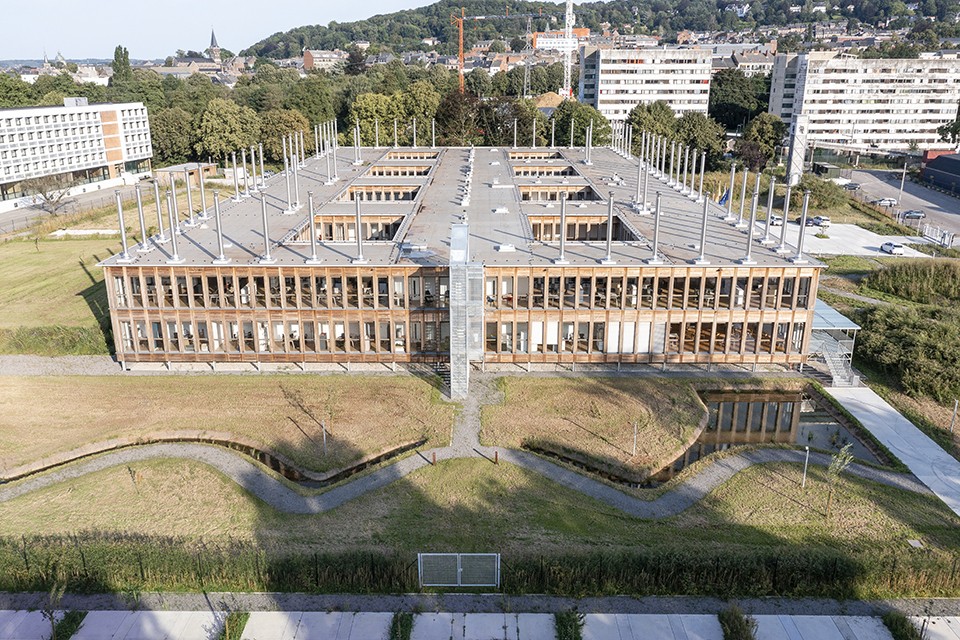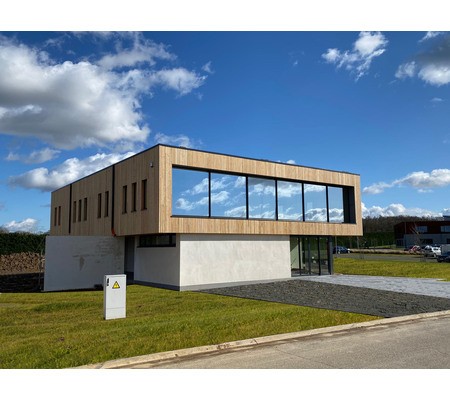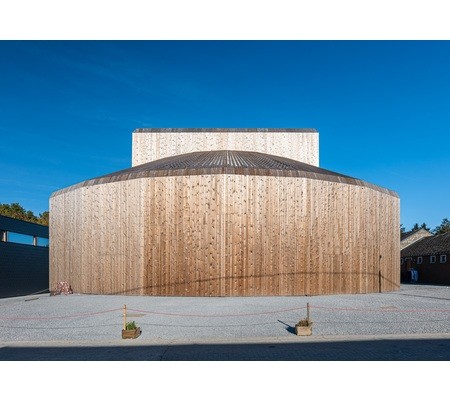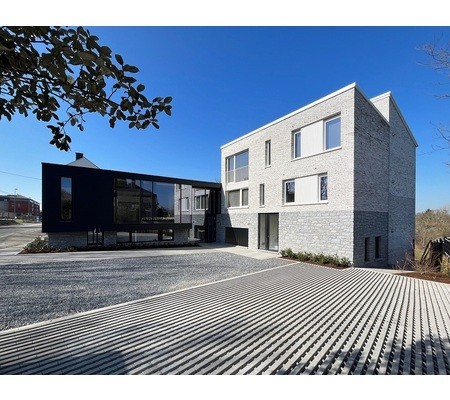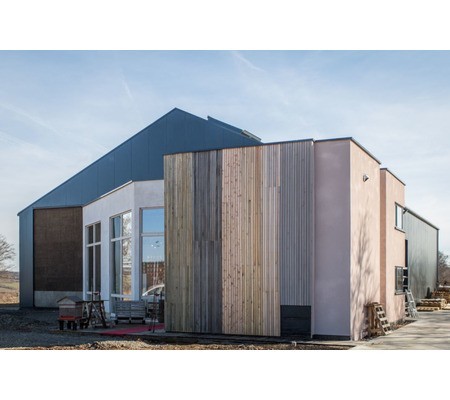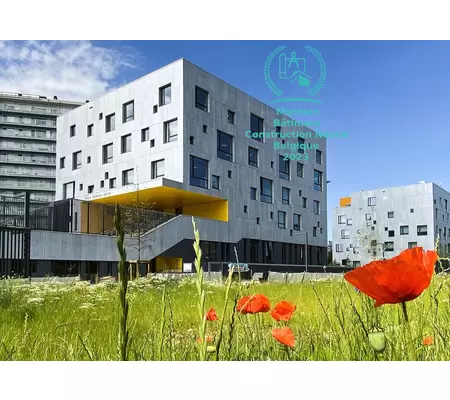Administrative house of the Province of Namur
Last modified by the author on 17/01/2023 - 20:32
New Construction
- Building Type : Office building < 28m
- Construction Year : 2021
- Delivery year : 2021
- Address 1 - street : Rue Henri Bodart 5000 SALZINNES, Belgique
- Climate zone : [Cbc] Mild, dry winter, warm and wet summer.
- Net Floor Area : 10 133 m2
- Construction/refurbishment cost : 17 792 607 €
- Number of Work station : 400 Work station
- Cost/m2 : 1755.91 €/m2
Certifications :
-
Primary energy need
115.92 kWhep/m2.an
(Calculation method : Other )
Sponsor's grand design
An important socio-economic and cultural player, the Administration of the Province of Namur brings together almost all of its services in a building to be built on its Salzinnes site. By establishing itself on the outskirts and on the banks of the Sambre rather than in a place of very high visibility in the city centre, the Province of Namur is adopting a position that is both strong and sensitive, an expression of the vision it has of his role.
This establishment should constitute a center of attraction on the scale of the city and allow the peripheral district to be complementary to the centre. It is therefore a question of creating a construction capable of generating a deep affection for this new intellectual pole of Namur.
The image of a village heart, which reflects the rural character of the province and the symbiosis with nature, naturally comes to mind. It invites us to enjoy our five senses through art and culture.
The construction of the Administrative House of the Province of Namur (MAP) represents a significant cost, not only financial but also environmental. The project thus aims to obtain the maximum number of BREEAM credits while highlighting the limits of this approach, as well as the questions it raises. The project achieved a score of 93.53%, or 8.53 margin points above the “Outstanding” level.
Genius Loci
Located in the hollow of a meander of the Sambre which surrounds it on its north-west flank, the site of the new MAP is bordered to the north-east by the former Grand Séminaire, a masterful work by Roger Bastin, with refined simplicity. . Also noteworthy in the South-West is the former Saint-Aubain School and, in the South-East, a set of 10-storey housing bars, a high voltage line, one of the pylons of which partially encroaches on the site and a secondary railway track giving access to the Central Workshops of Salzinnes of the SNCB.
The emphasis placed on urban agriculture in the Specifications for the call for tenders, part of a centuries-old Namur tradition, brings an artistic and poetic dimension to the project . It leads to assigning the entire North-East part of the site, ie 3300 m², to gardens and vegetable gardening, in continuity with the existing urban vegetable gardens. Botanical science and horticultural technology combine here with the art of the garden, the vegetable garden, the orchard, the nursery, where shapes, colors, smells, flavors mingle with the chirping of birds and the buzzing of insects as well as play of shadows and light. Natural ventilation and lighting, plants and flowers, weathered materials… everything in the project is part of this movement.
Location
The building forms a large rectangle of 106.2 mx 61.65 m. It is located as far as possible from the Sambre, outside areas of theoretical risk of flooding , at a good distance from the noise of the trains running along the other bank.
It is logically connected to the various possible access routes, whether it is rue Henri Bodart to the east , the possible route to be created to the south-west along theSambre, or the pedestrian bridge crossing the railway tracks to the South-East .
Its location also offers the necessary breathing space for both the Grand Séminaire de Bastin and the buildings in the South-West .
The layout along the North-West / South- East diagonal allows optimal orientation of the facades and functions: work and cartage to the East , reception and ceremonial entry to the South , parties to the West (with the village square used as a car park) and the dream or meditation spaces to the North .
The whole is therefore established naturally, without unnecessary contortions, like a large farm or a small village.
A village building organized around patios
Entirely built in wood and steel on two levels 3.6 m high, placed on steel piles , the building is covered by a submerged roof serving as a water tower and surmounted by a photovoltaic umbrella .
The plan is organized around eight rectangular patios of 15.3 mx 11.25 m side. Covered by opening greenhouse windows, the patios bring fresh air into the building. Their white facades maximize the penetration of natural light and the windows open completely in the event of a fire to transform the covered patios into outdoor spaces.
This arrangement of the plan makes it possible to illuminate and naturally ventilate the trays at any point, which makes it possible to assign them to a wide variety of programs or functions.
The construction limited to two levels allows fluid communication between all points of the building, thus promoting team spirit, the "New World of Work" and accessibility for people with reduced mobility.
The ground floor includes a friendly reception area, a cafeteria that can accommodate nearly 300 people, rooms to receive visitors, a relaxation room and a sports hall equipped with showers. A large workshop, storage spaces and locker rooms for maintenance staff will complete this set.
The first floor accommodates most of the offices distributed in different areas, but also spaces conducive to concentration, various meeting rooms for teamwork, or even relaxation areas to share friendly moments with colleagues.
The four facades, all in wood, consist of a very calm alternation of overmantels and open windows from floor to ceiling (108 cm wide on the interior side and 101.25 cm on the exterior side). equipped with safety guardrail, the windows are openable and allow everyone to enjoy the view of the gardens.
The orthogonal grid
The plan is rigorously organized on a constructive frame of 1.35 m side. The orthogonal plan almost naturally induces an archetypal layout of the major thoroughfares: the “Cardo” from North to South and the “Decumanus” from East to West, following the example of Roman cities. It is from the central square, which is at their intersection, that the activity spreads to the “districts”, then to the “neighborhoods”.
The stiffness of orthogonality is only apparent. It is only the necessary and useful base for the free expression of diversity and poetry. It is precisely the fragrance of humanism and culture that transpires from the grand design of the sponsor that encourages us to propose this neutral structure to allow the gentle and joyful expression of diversity.
Harmonious diversity
Rather than in the structure and envelope of the building, it is in the choice of finishes, textiles, leather, wallpaper, basketwork, enhanced by artistic interventions, that the essential diversity of interior spaces is created. The walls, partitions and partitions are dressed in them, carpets of all kinds cover the floor, chandeliers, sculptures and other pleasant and useful objects can be hung from the wooden ceiling.
The same goes for furniture (apart from that which specifically comes under the Code on Well-being at Work, such as workstation seats). The project proposes furniture elements reused or made from supplies from the Ressourcerie Namuroise but each of the occupants, in respect and in dialogue with the others, can also propose a chair, a table, a wardrobe that expresses their personality.
It is therefore a question of trying to use only second or third visual choice, re-use or recycled, making sure that it makes sense socially and culturally, that it becomes poetic. This must give a soul to the building and generate the affection of all users. The approach must then be perceived as exemplary for a public administration.
Natural ventilation
The ambition to offer the best indoor climate possible with the minimum environmental footprint leads to offering natural ventilation for the building.
When, as here, the outside air has the desired quality, it is recognized that the natural ventilation of a building is not only more pleasant but also more hygienic than that carried out mechanically with conditioned air distributed by air ducts. It also turns out to be more economical , both in terms of investment cost and operating and maintenance cost, the main saving coming from the absence of energy-consuming installations intended to set the air in motion and cool it. , and this, notwithstanding the non-recovery of energy on the hot air extracted in winter.
Interior ventilation in cool weather is provided by the static ventilators at the top of the patio windows, at the foot of which are placed floor convectors. Air is evacuated by natural draft via chimneys located every 4.05 m to the right of the South and North facades, in the central East-West axis and in the center of the three central crossing wings.
On summer nights, the free cooling of the terrazzo floors is ensured by the opening of the windows of the patios, which are sheltered from the rain under the glass roofs.
Renewable energies
In the case of this project, among the technologies that can be used today, only those that use solar energy and geothermal energy with a heat pump can be used.
Solar thermal energy would be inefficient in this case. Wind power could make very efficient use of the winds present on the site, but would produce too much noise. Cogeneration would duplicate solar and geothermal energy. The kinetic energy of the river would be too low given the slowdown generated by the locks. Finally, the quantity of biomass present on the site is too low to consider its energy exploitation, whereas it is particularly useful as fertilizer.
Parking, roads, access
The car entrances to the site (main entrance and car park entrance) are located in front of the long south-west facade of the building, from the road giving access to the former Saint-Aubain Institute from rue Bodart. This road may be extended in the future along the banks of the Sambre to the south in connection with avenue Woitrin.
Staff and visitors coming from rue Marinus by public transport or by bicycle can also, like people with reduced mobility, take the elevator located in the extension of the footbridge in the south-east corner of the site and reach the main entrance by a covered gallery. The entrance for heavy vehicles is located in the northeast corner of the site.
Of the 371 parking spaces provided for cars, 12 are reserved for people with reduced mobility and 30 for visitors near the entrance, 12 are equipped with electric charging stations, 28 are reserved for carpooling and 12 (including one for people with reduced mobility) are allocated to personnel in the delivery area. 30 parking spaces for motorcycles are provided near the “village square” and 103 covered spaces for bicycles are provided under the awnings and galleries.
The approaches
The open ground is entirely dedicated to market gardening and staff relaxation (sports grounds could also be considered there), it consists of different gardens divided into three parts:
- in the North-East: the didactic garden , with its growing area in the ground (next to the greenhouse and the nursery) and its growing area in containers, as well as the production garden of vegetables for staff;
- in the North-West: the large garden of biodiversity and relaxation with its fitness trail and its personalized insect hotels (we also recover as much as possible of the existing asphalted area, treated artistically so as not to destroy it);
- in the South-West: the perfume rose garden and the therapeutic garden .
Building: 10,133 m²; land: 32,616 m²; 2017 - 2021; (01/640).
Services performed
- Town planning
- History of the site
- Microclimate
- Hydrogeology
- Architecture
- Interior design
- Surroundings and landscaping
- Structural engineering
- Engineering of special techniques
- Technical commissioning of installations
- Building physics, PEB
- Energy Smart Grid
- Air quality
- Natural lighting
- BREEAM certified
- Acoustic
- Signage
- Accessibility
- Fire safety
Distinction : Regional Western Europa BREEAM AWARD 2022
Tender selected following a restricted "design and construction" call for tenders on behalf of Entreprises Jan De Nul.
Resilience
Hazards to which the building is exposed:
- Flood/Rapid Flood
Resilience measures put in place:
- The building was located to the east of the site, as far as possible from the Sambre, outside the theoretical areas of currently "high" and "medium" risk of flooding . It is placed on stilts .
- The level of its ground floor is set at 84.80 m to take into account a possible deterioration of the situation in the future.
- The flood hazard corresponding to an overflow of the Sambre, no passive drainage system can be envisaged . The building is therefore founded on the bedrock to avoid having to stabilize the level of the water table.
Data reliability
Self-declared
Photo credit
Project author: Philippe SAMYN and PARTNERS, architects & engineers
Photos: Quentin OLBRECHTS and Henri COLLETTE
Contractor
Construction Manager
Stakeholders
Structures calculist
Cerfontaine sprl
Ir David Janssen
Stability engineering with Samyn and Partners
Other consultancy agency
Flow Transfer International sa
Ir Andrew Janssens
Special technical engineering with Samyn and Partners
Environmental consultancy
Matriciel sa
Ir Fabrice Derny
Building physics and EPB advisor
Structures calculist
Acoustic Technologies sa
Ir Jean-Pierre Clairbois
Acoustic Advisor
Environmental consultancy
Ceanero asbl
Dr Cécile Goffaux, Ir Arnaud Candaele, Ir Kevin Siau
Dynamic simulations and micro-climates
Environmental consultancy
BOPRO nv
Michaela Vernimmen, Ermal Kapedani
BREEAM consultant
Company
MOBIC sa
Jean-Philippe Moutschen; Patrick Moutschen
https://www.mobicsa.be/Wood frame construction (local wood)
Company
Les Ateliers Remy
Gabriel Remy
https://www.ateliersremy.beRealization of the staircase in perforated sheet metal
Contracting method
Other methods
Energy consumption
- 115,92 kWhep/m2.an
- 165,77 kWhep/m2.an
Systems
- Geothermal heat pump
- Heat pump
- Geothermal heat pump
- Natural ventilation
- Solar photovoltaic
- Heat pump
Risks
- Flooding/Fast Recession
Urban environment
- 32 616,00 m2
- 31,07 %
Product
Galvanized exterior staircase
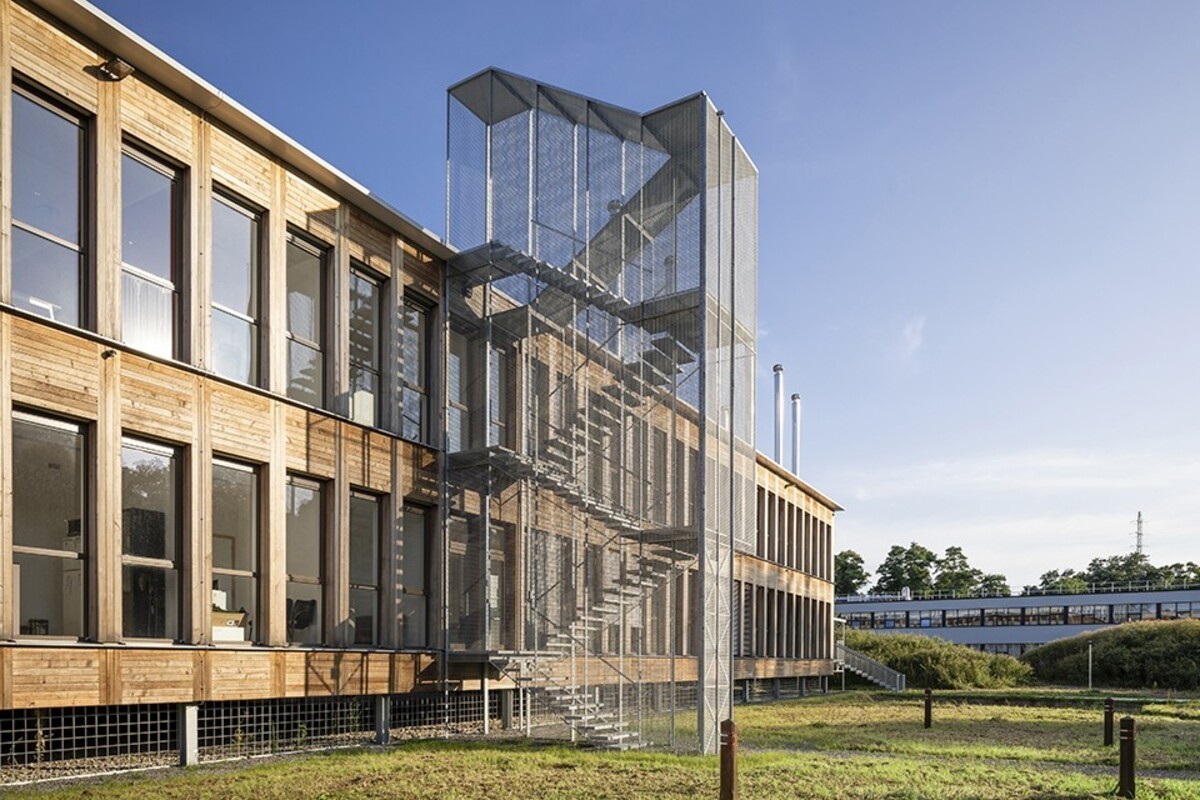
Les Ateliers Remy
[email protected]; Gabriel Remy
http://ateliersremy.be/
https://www.construirelawallonie.be/article/un-escalier-unique-comme-carte-de-visite-professionnelle/
Roof chimneys
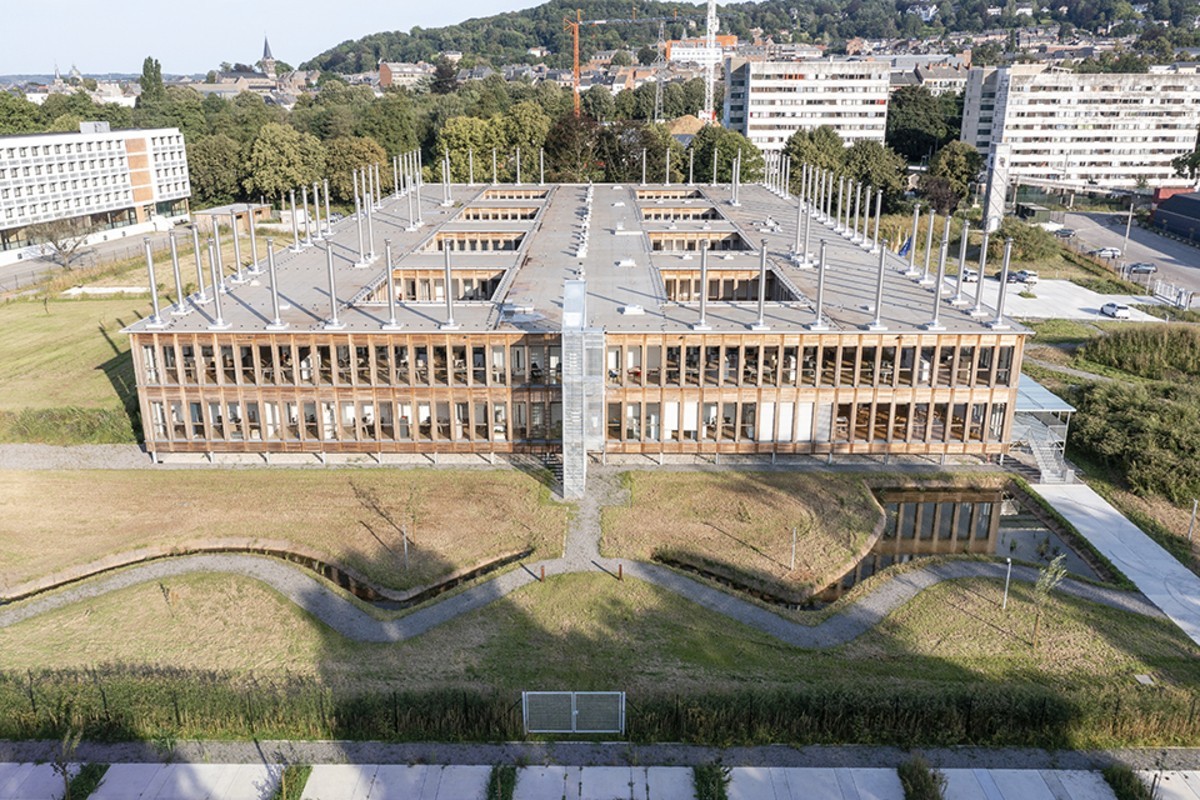
Eeckhout bv
https://eeckhoutbv.be/Génie climatique, électricité / Ventilation, rafraîchissement
The building is equipped with 74 insulated stainless steel shunt chimneys 5 m high which ensure the natural ventilation of the building.
External active solar protections
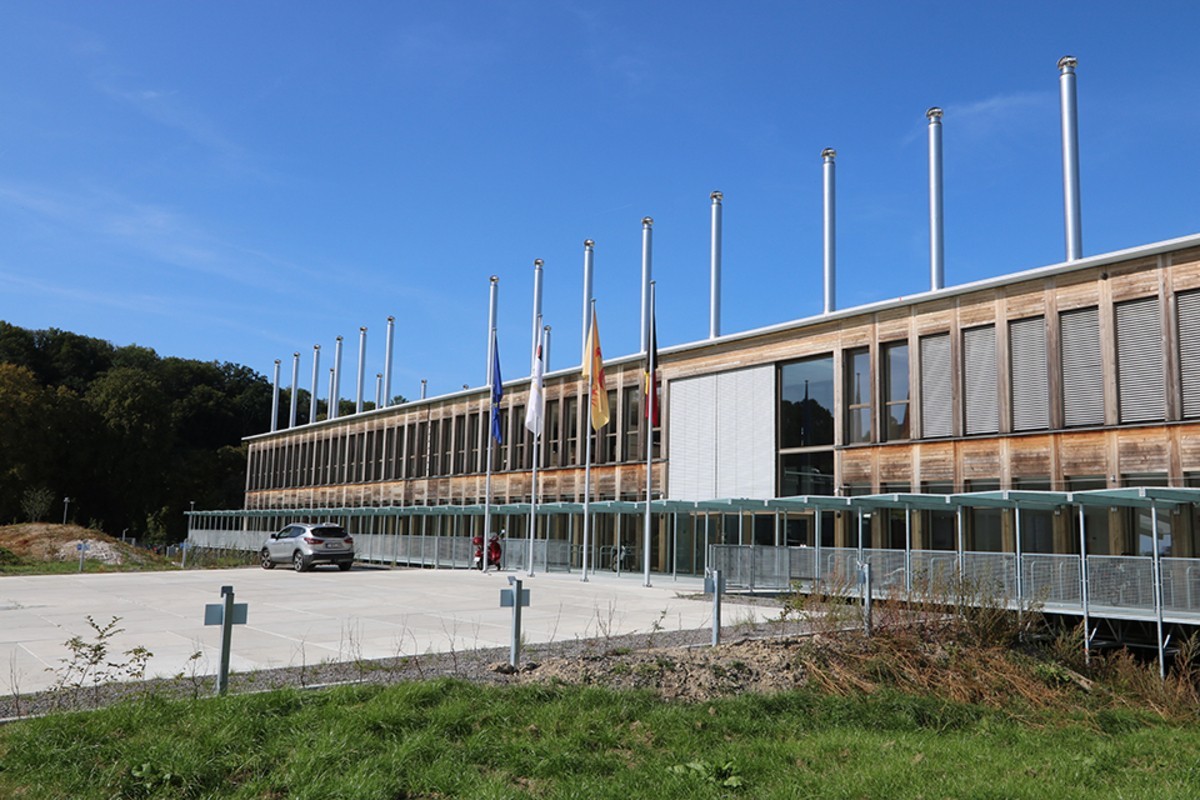
F.D.S.
https://www.fds.be/fr/protections-solaires-exterieures
The exterior bays are equipped with external blinds with adjustable slats automatically controlled by facade linked to the level of sunshine and the position of the sun with individual override control by room or by structural span of 4.05 m.
Exterior passageways on the facade
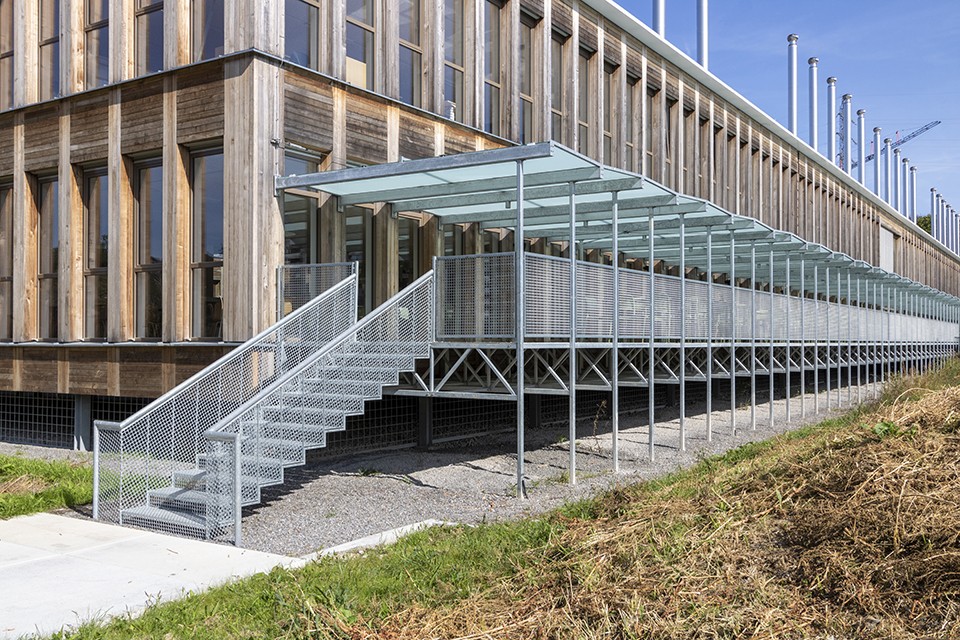
TAMCO sprl
info[a]tamco.be; mathieu.gevers[a]tamco.be; Mathieu Gevers
https://tamco.be/
The gently sloping entrance esplanade which leads to the passageway, which one crosses to enter (interface between the exterior and the interior) and which is covered and glazed, also distributes the nursery and serves as entry to other functions open to the public. It also serves as a link with the service area on the east facade.
It houses the bicycle parking area and is also accessible by an access ramp at the end coming in a straight line from the urban lift.
It also serves as a cafeteria terrace.
Structure entirely in local wood + facade cladding in torrefied poplar planks
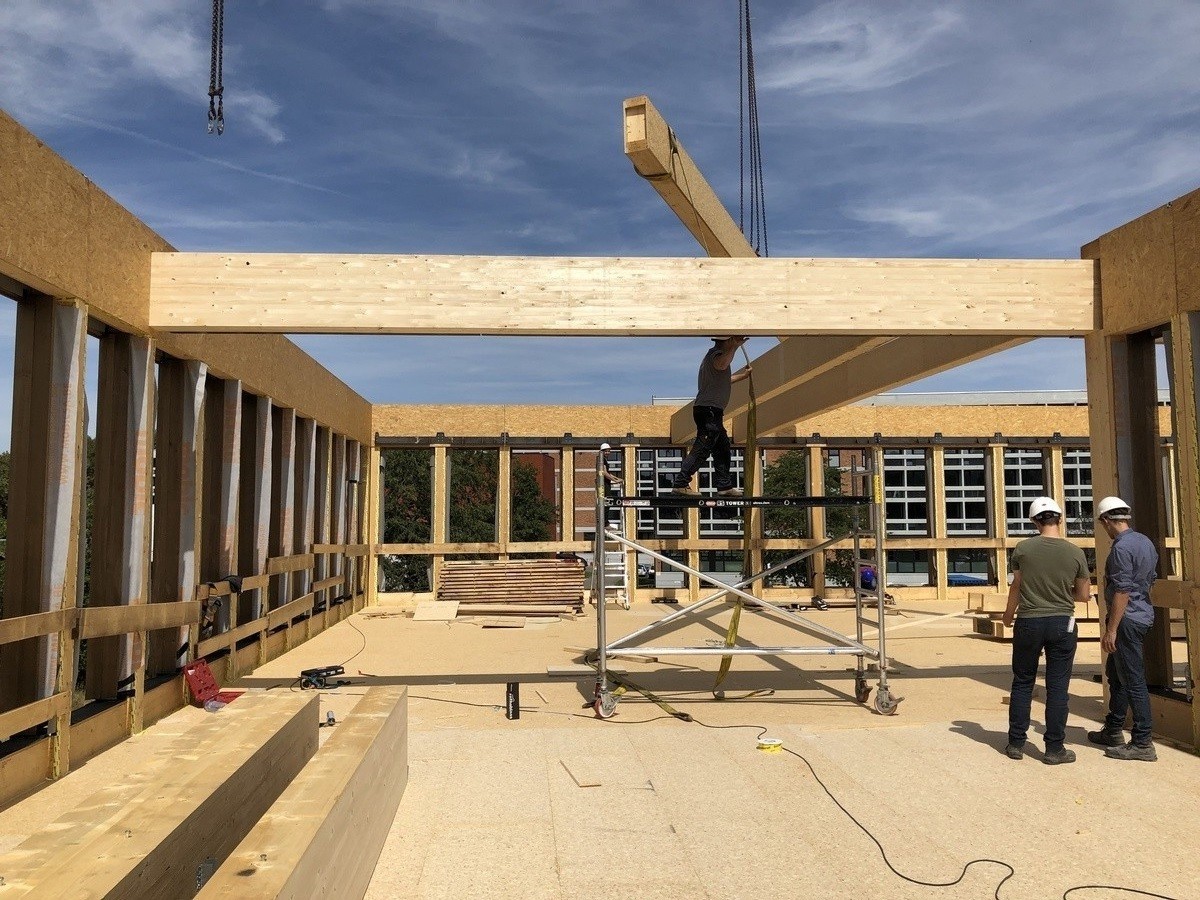
MOBIC sa
Jean-Philippe et Patrick Moutschen
https://www.mobicsa.be/Second œuvre / Menuiseries extérieures
The wooden structure (locally sourced) includes 12.15 m span beams in the form of boxes. These consist of small triangulated elements in solid wood assembled by "skins" in OSB panels fixed to the solid elements by robotic screwing. The cohesion of the whole is such that the panels are sufficient to absorb all the forces at the nodes of the beams, without bolted assembly.
The facades are assemblies of prefabricated elements (2.70m w x 8.10m h), each composed of columns and lintels with roasted poplar cladding. Steel angles (L-profiles) are attached to these facade elements in order to support the planks, also made of prefabricated beams.
Prefabrication allows serious economies of scale, to optimize transport and to shorten the time of intervention on site, which also costs money.
Parking slabs
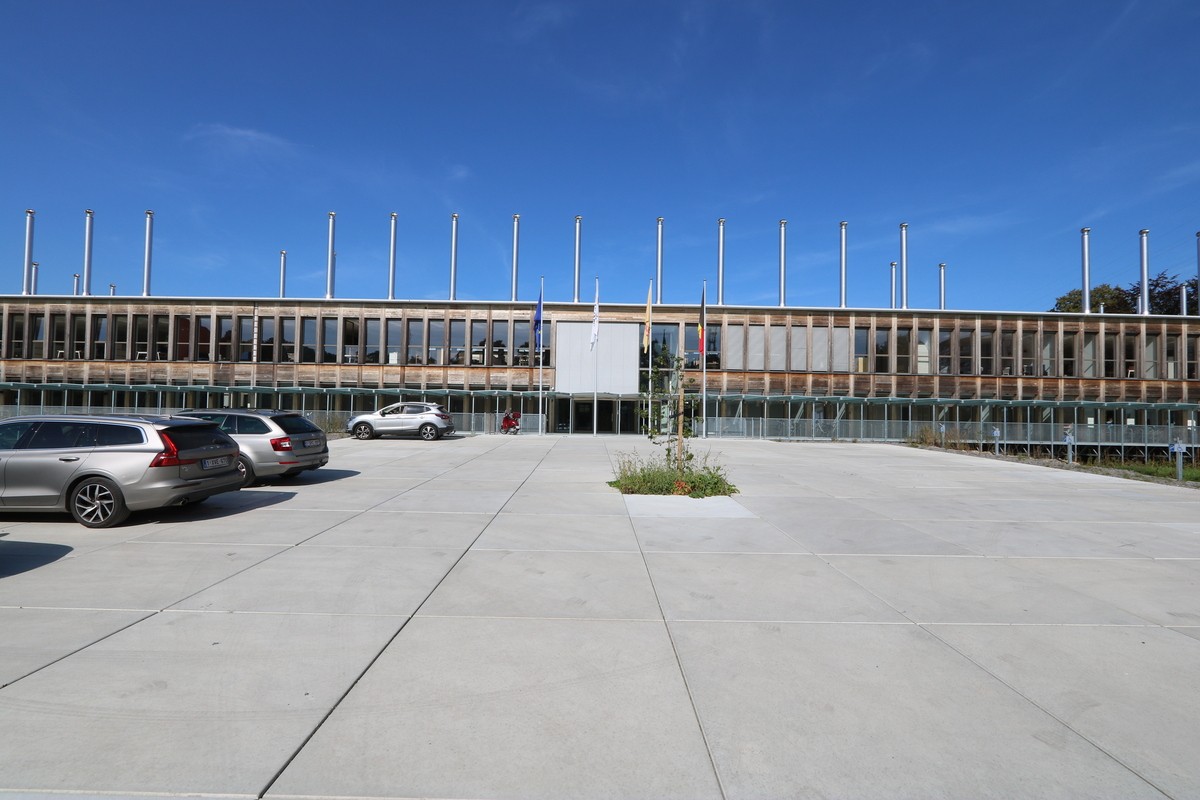
EURODAL nv
info[a]eurodal.be
https://eurodal.be/
The car park is made of large prefabricated concrete slabs, with open joints (and therefore permeable).
Construction and exploitation costs
- 17 972 607 €
Reasons for participating in the competition(s)
Location
The whole is set up without unnecessary contortions, like a large farm or a small village. The real angles of 37° (= arctg (3/4)) of the Bastin and 26.565° (= arctg (1/2)) of the project with respect to the cardinal axes add additional richness to the play of light with the orientation and the season .
The building, on steel stilts , is entirely in wood on two levels and covered by the photovoltaic umbrella and surmounted by 74 natural ventilation chimneys . It is located to the east from the site, as far as possible from the river, outside the theoretical areas of currently "high" and "medium" risk of flooding, and avoiding the noise of trains on the left bank of the Sambre. The elevation of the building offers the possibility of a fresh air intake through the void between piles to supply the natural ventilation system.
Thus located in the less flood-prone area, the building is bordered by vegetable and flower-filled parks, bathed in sunlight from morning to evening: the didactic and appropriation gardens in the ground and in containers as well as the production garden along its length. on the north-east side, the large "biodiversity garden - eventually completed with a relaxation area" (with its fitness trail) on its north-west side and finally the therapeutic garden on its south-west side. Spaces for rest and contemplation will be set up along undulating paths, inviting informal meetings and relaxation.
On the other hand, the reason imposes to arrange the car parks on the surface. The cost, both financial and environmental, of an underground car park, ultimately useless, in flood-prone terrain cannot be justified. The car park therefore occupies the "village square", in the most flood-prone area, on the banks of the Sambre and it is designed in the most compact way to consume a minimum of green space while preserving all the existing trees.
Clarifications on the risk of flooding
According to the Flood Portal database of the SPW (Service Public de Wallonie), the high flood hazard locally corresponds to the ground level of 82.0 m, while the medium and low hazards correspond respectively to the 82.6 m level. m and 82.8 m. These floods are reported as due to the overflow of the Sambre.
In consideration of this risk of flooding (and other criteria such as prevailing winds, ambient noise, mobility, etc.), the building is located in a low hazard zone. The level of its ground floor is set at 84.80 m to take into account a possible deterioration of the situation in the future. This level is comparable to that of the former Grand Séminaire (architect Roger Bastin), present to the north of the site, whose ground floor is located at level 85.18 m.
The flood hazard corresponding to an overflow of the Sambre, no passive drainage system can be envisaged. The building is therefore founded on the bedrock to avoid having to stabilize the level of the water table.
Building candidate in the category





